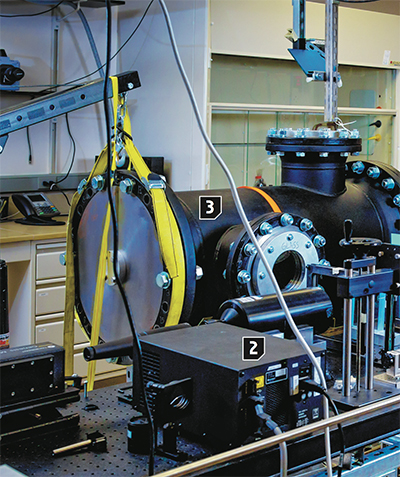2.23.16
Dynamic Multifunctional Materials Laboratory
Leslie Lamberson knows a thing or two about pushing past limits. In the three and half years that she’s been at Drexel — where she is an assistant professor in the College of Engineering — she spent the first two building a one-of-a-kind materials testing lab pretty much from scratch.
Here, she studies how things break.
“We push materials to their extremes to get a better understanding of their behavior under complex, real-world loading conditions,” says Lamberson. “If you know how something breaks, that knowledge informs design.”
So far, her research has included replicating asteroid impacts, designing protective athletic gear and examining cortical bone fractures.
“I think the saying is that you don’t truly know yourself until you push yourself past your limits — it’s the same thing for materials,” she says.


1 /// Lamberson: She has advanced degrees in aeronautics and aerospace engineering, but there’s a soft side to this scientist, too: She has a bachelor’s in dance performance from the University of Michigan. She still studies classical ballet today, and even teaches a fitness ballet barre class at Drexel.
2 /// The Lab: Lamberson hand-designed and built nearly every piece of equipment in her lab, piecing together parts she acquired from bargain hunter sites such as eBay, Craigslist and Harbor Freight. There’s even an Ikea bedframe in her lab, resourcefully standing in for a more expensive piece of scaffolding.
3 /// Light-gas gun: Lamberson designed and built this two-stage light-gas gun, which can propel a projectile into a target at over 7,000 mph, at a cost of just $30,000 — what it costs to run the NASA Ames Vertical Gun Range (a similar facility) for just one week. One way Lamberson uses the device is to replicate the pressure profiles of an IED explosion on the battlefield — information that can be used to improve the protective foams inside soldier’s helmets.
4 /// Crack camera: Lamberson’s lab is equipped with high-speed cameras and optical diagnostics to capture images at rates of up to 375,000 frames per second. This allows Lamberson to study how materials fail at the moment of impact by observing frame-by-frame deformations, accelerations and fracture properties of growing cracks.
5 /// Kolsky bar: This is a Kolsky bar, also known as a split-Hopkinson pressure bar, which is an apparatus used to measure how materials respond to dynamic strain-rates. A researcher places a material to be tested between two long cylindrical bars and then launches a short striker bar on the uprange end, creating a stress wave that propagates through the test material. “It’s essentially a workhorse of dynamic material behavior,” says Lamberson, who uses the equipment to study the effect of rate-dependent compression on materials.
6 /// Contents under pressure: With so much specialized equipment, electrical wiring and, well, projectiles in Lamberson’s lab, special modifications have been made to the room. All of the glass windows are covered with a thick layer of polycarbonate strong enough to withstand a bullet shot point blank from a rifle, and the doors are specially rigged so the gas-gun cannot re until all doors are closed and people are safely on the other side.


